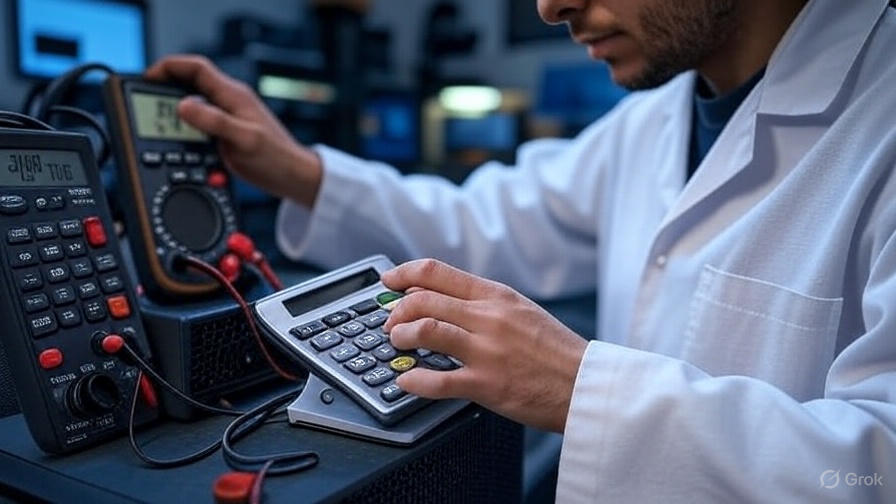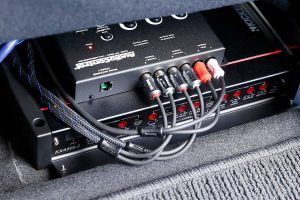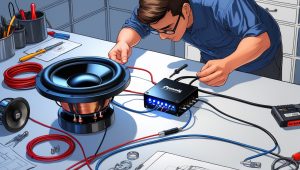Audio systems can make or break your listening experience, and one crucial factor that determines sound quality is the impedance matching between your amplifier and speakers. Many audio enthusiasts struggle with calculating the total ohm load on their amplifiers, which can lead to poor performance, damaged equipment, or disappointing sound quality.
The impedance load affects how much power your amplifier delivers to your speakers. When you connect multiple speakers to a single amplifier, the total impedance changes based on how you wire them together. Getting this calculation right ensures optimal performance and prevents costly equipment damage.
Contents
- What Is Impedance and Why Does It Matter?
- Series vs. Parallel Speaker Connections
- Step-by-Step Calculation Methods
- Practical Calculation Examples
- Common Mistakes to Avoid
- Tools and Resources for Accurate Calculations
- Amplifier Matching and Performance Optimization
- Advanced Impedance Concepts
- Troubleshooting Impedance Issues
- Conclusion
What Is Impedance and Why Does It Matter?
Impedance represents the opposition to electrical current flow in an AC circuit. In audio systems, impedance is measured in ohms (Ω) and typically ranges from 2 to 16 ohms for most consumer speakers. Your amplifier is designed to work with specific impedance loads, usually 4, 8, or 16 ohms.
When the impedance load drops too low, your amplifier draws more current and generates excess heat. This can trigger protective circuits or cause permanent damage. Conversely, when the impedance load is too high, your amplifier delivers less power, resulting in quieter sound and reduced dynamic range.
Most amplifiers perform best when matched to their designed impedance rating. A 100-watt amplifier rated for 8 ohms will deliver its full power into an 8-ohm load. Connect a 4-ohm speaker, and the amplifier typically delivers more power but runs hotter. Connect a 16-ohm speaker, and you get less power but cooler operation.
Series vs. Parallel Speaker Connections
The way you connect multiple speakers determines the total impedance your amplifier sees. Two primary methods exist: series and parallel connections. Each method affects the total impedance differently.
Series Connection Basics
In a series connection, you connect the positive terminal of one speaker to the negative terminal of the next speaker. The remaining positive and negative terminals connect to your amplifier. This creates a single path for current to flow through all speakers.
Series connections add individual impedances together. If you connect two 8-ohm speakers in series, the total impedance becomes 16 ohms. Three 8-ohm speakers in series create a 24-ohm load. The formula is straightforward:
Total Impedance = Speaker 1 + Speaker 2 + Speaker 3 + … + Speaker N
Parallel Connection Fundamentals
Parallel connections involve connecting all positive terminals together and all negative terminals together. This creates multiple paths for current to flow. The total impedance in parallel connections is always lower than the lowest individual speaker impedance.
For parallel connections, you need to use the reciprocal formula:
1/Total Impedance = 1/Speaker 1 + 1/Speaker 2 + 1/Speaker 3 + … + 1/Speaker N
Two 8-ohm speakers in parallel create a 4-ohm load. Three 8-ohm speakers in parallel result in approximately 2.67 ohms. Four 8-ohm speakers in parallel produce a 2-ohm load.
Step-by-Step Calculation Methods
Calculating Series Impedance
Start by identifying each speaker’s impedance rating. This information appears on the speaker’s label or in the manufacturer’s specifications. For series calculations, simply add all impedance values together.
Example 1: Two speakers with 8-ohm and 4-ohm impedances Total Impedance = 8Ω + 4Ω = 12Ω
Example 2: Three speakers with 8-ohm, 8-ohm, and 16-ohm impedances Total Impedance = 8Ω + 8Ω + 16Ω = 32Ω
Calculating Parallel Impedance
Parallel calculations require the reciprocal formula. Start by converting each impedance to its reciprocal (1/impedance), add these values, then take the reciprocal of the sum.
Example 1: Two 8-ohm speakers in parallel 1/Total = 1/8 + 1/8 = 2/8 = 1/4 Total Impedance = 4Ω
Example 2: Three different speakers (8Ω, 4Ω, 16Ω) in parallel 1/Total = 1/8 + 1/4 + 1/16 = 2/16 + 4/16 + 1/16 = 7/16 Total Impedance = 16/7 ≈ 2.29Ω
For equal impedances in parallel, use this shortcut: Total Impedance = Individual Impedance ÷ Number of Speakers
Mixed Series-Parallel Configurations
Real-world systems often combine series and parallel connections. Calculate these complex configurations in stages, working from the inside out.
Example: Two 8-ohm speakers in parallel, connected in series with a 4-ohm speaker
Step 1: Calculate the parallel pair Two 8-ohm speakers in parallel = 4Ω
Step 2: Add the series speaker Total = 4Ω + 4Ω = 8Ω
Practical Calculation Examples
Home Theater Setup
Consider a 5.1 surround sound system where you want to connect multiple speakers to a single amplifier channel. You have:
- Two front speakers: 8 ohms each
- Two rear speakers: 6 ohms each
- One center speaker: 4 ohms
If you connect the front speakers in parallel: 1/Total = 1/8 + 1/8 = 1/4 Front pair impedance = 4Ω
If you connect the rear speakers in parallel: 1/Total = 1/6 + 1/6 = 1/3 Rear pair impedance = 3Ω
Now you have three loads that could be combined:
- Front pair: 4Ω
- Rear pair: 3Ω
- Center: 4Ω
Car Audio System
Car audio systems often require creative wiring to achieve the desired impedance. Suppose you have four 4-ohm subwoofers and want to present an 8-ohm load to your amplifier.
Option 1: Wire pairs in series, then parallel the pairs
- Series pair 1: 4Ω + 4Ω = 8Ω
- Series pair 2: 4Ω + 4Ω = 8Ω
- Parallel the pairs: 8Ω ÷ 2 = 4Ω (This gives 4Ω, not 8Ω)
Option 2: Wire pairs in parallel, then series the pairs
- Parallel pair 1: 4Ω ÷ 2 = 2Ω
- Parallel pair 2: 4Ω ÷ 2 = 2Ω
- Series the pairs: 2Ω + 2Ω = 4Ω (Still 4Ω)
To achieve 8Ω with four 4-ohm speakers, you’d need to wire all four in series: 4Ω + 4Ω + 4Ω + 4Ω = 16Ω, which is too high.
PA System Configuration
Professional audio systems often use multiple identical speakers. For a PA system with eight 8-ohm speakers, you have several wiring options:
All in parallel: 8Ω ÷ 8 = 1Ω (Too low for most amplifiers) All in series: 8Ω × 8 = 64Ω (Too high for most amplifiers)
Better approach: Create two parallel groups of four speakers each, then connect the groups in series:
- Group 1: 8Ω ÷ 4 = 2Ω
- Group 2: 8Ω ÷ 4 = 2Ω
- Total: 2Ω + 2Ω = 4Ω
Common Mistakes to Avoid
Ignoring Minimum Impedance Ratings
Many amplifiers have minimum impedance ratings. Connecting speakers that present a lower impedance can damage your amplifier. Always check your amplifier’s specifications before connecting speakers.
Mixing Different Impedance Speakers Carelessly
When you mix speakers with different impedances in parallel, the lower-impedance speakers receive more power. This can cause volume imbalances and potentially damage higher-impedance speakers.
Forgetting About Power Distribution
In series connections, speakers with higher impedance receive more power. In parallel connections, speakers with lower impedance receive more power. This affects both volume levels and speaker longevity.
Assuming Nominal Impedance Is Actual Impedance
Speaker impedance varies with frequency. The nominal rating (like 8 ohms) represents an average value. Actual impedance can range from 6 to 12 ohms across the frequency spectrum for an “8-ohm” speaker.
Tools and Resources for Accurate Calculations
Online Impedance Calculators
Several websites offer free impedance calculators. These tools let you input your speaker configurations and automatically calculate the total impedance. Popular options include speaker impedance calculators from Parts Express, Crutchfield, and various audio forums.
Mobile Apps
Smartphone apps can help with impedance calculations on the go. Apps like “Speaker Impedance Calculator” and “Audio Calculator” provide quick calculations for series, parallel, and mixed configurations.
Digital Multimeters
A digital multimeter can measure actual speaker impedance. Set the meter to resistance mode and measure across the speaker terminals. Remember that this gives DC resistance, which is typically lower than AC impedance.
Software Solutions
Audio design software like WinISD, BassBox Pro, and Speaker Workshop include impedance calculation features. These programs are particularly useful for complex multi-driver systems.
Amplifier Matching and Performance Optimization
Power Output Considerations
Amplifier power output varies with load impedance. Most amplifiers deliver their rated power into their designed impedance. A 100-watt amplifier rated for 8 ohms typically delivers:
- 200 watts into 4 ohms
- 50 watts into 16 ohms
These relationships help you predict how impedance changes affect volume levels.
Thermal Management
Lower impedance loads cause amplifiers to work harder and generate more heat. Ensure adequate ventilation when running low-impedance loads. Some amplifiers include thermal protection that reduces power when temperatures rise.
Stability and Protection Circuits
Modern amplifiers include protection circuits that prevent damage from impedance mismatches. These circuits may reduce power, shut down the amplifier, or activate cooling fans when they detect potentially harmful conditions.
Advanced Impedance Concepts
Reactive Impedance
Speakers present reactive impedance that varies with frequency. This impedance includes both resistance and reactance components. Crossover networks, driver characteristics, and enclosure design all affect reactive impedance.
Impedance Curves
Professional speaker specifications often include impedance curves showing how impedance varies across the frequency spectrum. These curves help predict real-world performance better than simple nominal ratings.
Complex Load Compensation
Some high-end amplifiers include complex load compensation circuits that adjust their output based on the connected impedance. These features help maintain consistent performance across different speaker loads.
Troubleshooting Impedance Issues
Symptoms of Impedance Problems
Common signs of impedance mismatches include:
- Amplifier overheating
- Reduced power output
- Distorted sound
- Protective circuit activation
- Uneven volume between speakers
Testing and Verification
Use a multimeter to verify your impedance calculations. Measure the total impedance at the amplifier terminals with all speakers connected. Compare this measurement to your calculated value.
Corrective Measures
If your calculated impedance doesn’t match your amplifier’s requirements, consider:
- Rewiring speakers in different configurations
- Adding or removing speakers
- Using impedance-matching transformers
- Upgrading to a different amplifier
Conclusion
Calculating total ohm load on amplifiers requires understanding the difference between series and parallel connections, knowing the impedance ratings of your speakers, and applying the correct mathematical formulas. Series connections add impedances together, while parallel connections use the reciprocal formula to create lower total impedances.
Start with simple configurations and work your way up to complex mixed arrangements. Always verify your calculations with actual measurements when possible, and ensure your final impedance matches your amplifier’s specifications. Remember that proper impedance matching not only prevents equipment damage but also ensures optimal sound quality and performance from your audio system.
The key to successful impedance matching lies in careful planning, accurate calculations, and thorough testing. Take time to understand your equipment’s specifications and don’t hesitate to consult manufacturer documentation or audio professionals when dealing with complex configurations. With practice, impedance calculations become second nature, and you’ll be able to design audio systems that deliver excellent performance and reliability.






